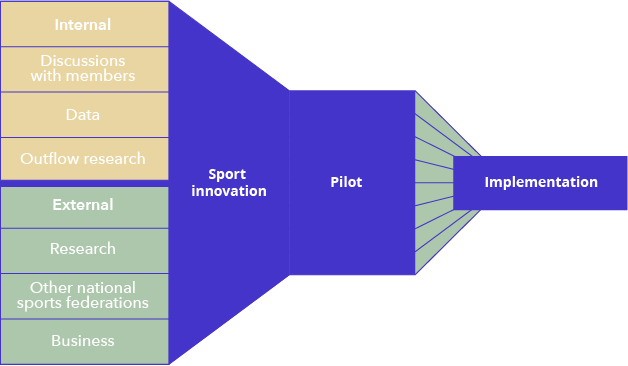CASE
STUDY
Reimagining Sports participation
Case study
Innovation within Dutch national sport federations
Researched by Joop Vriend
This research is part of Reimagine Sports, a research from the Amsterdam University of Applied Science. This project’s goal is to look to the future of (the organizations of) sports. The purpose of this research is to gain insights in the similarities and differences between the national sport federations about their knowledge and application of sportinnovations to commit the youth from 12-18 years to their clubs. This is important, because membership numbers decline in this category and national sport federations and sportclubs experience difficulties to be attractive to this group. Therefore the following research question has been formulated: “To what extent have 10 national sport federation, in the last five years, innovated their sport in relation to 12- to 18- year olds potential and existing club members? ” (Vriend, 2023)
Methodology
Qualitative research with semi-structured interviews
- 10 staff members of different national sport federations, who have something to do with innovation in their work.
- 1 interview with a staff member of NOC*NSF.

Methodology
Qualitative research with semi-structured interviews
- 10 staff members of different national sport federations, who have something to do with innovation in their work.
- 1 interview with a staff member of NOC*NSF.

Key Insights
- There is no one golden way that works to suddenly engage all 12- to 18-year-olds. It is a complex problem where multiple solution scan contribute to binding the target group.
- There are internally and externally-oriented reasons why this group drops out of sports associations.
- The most important recommendation remains to stay in good dialogue with members at all times and put their wants and needs first. That is going to yield the most results for member retention.
Key Insights
There is no one golden way that works to suddenly engage all 12- to 18-year-olds. It is a complex problem where multiple solution scan contribute to binding the target group.
There are internally and externally-oriented reasons why this group drops out of sports associations.
The most important recommendation remains to stay in good dialogue with members at all times and put their wants and needs first. That is going to yield the most results for member retention.
Field studies
Factors which influence the configuration of a sport innovation and process before implementation in a Dutch national sports federation

Final Results
Externally-oriented reasons are that athletes today pick sports more to look better, quit due to injuries and because the sport is no longer considered fun enough.
Internally-oriented reasons, why 12- 18-year-olds drop out, are all things that sports associations can influence. The reasons are lack of flexibility, dissatisfaction with the trainer of coach, team format, favouring talents and too much emphasis on competition.
Sports federations are betting on training good trainers and coaches.
Many of the sports federations do have new forms of sports, with advantages like smaller teams and easier implementation and being more accessible than their regular sports. But they’ re still in their infancy and not offered to the group of 12- to 18-year-olds.
Recommendations are continuing the focus on good trainers and coaches, but also offering new forms of sport to 12- to 18-year-olds, give them a choice in what form they want to do the sport and organize sport more to members’ wishes and offer alternative memberships.